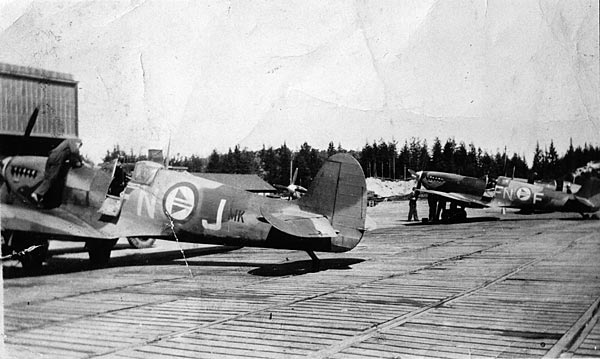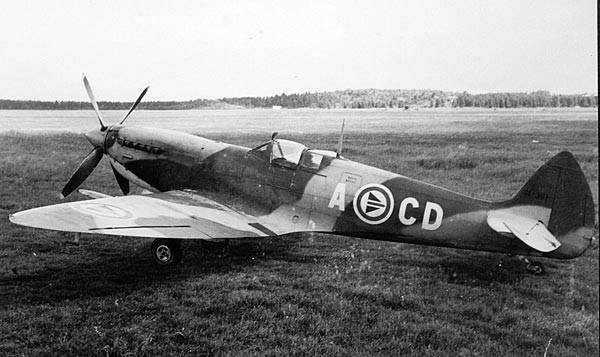From VenturaPublications.com
Spitfire MkIX - Norwegian post-war colours and markings
By Nils Mathisrud
Nov 20, 2006, 09:00
The Royal Norwegian Air Force operated 67 Spitfire Mk IX fighters and three PR XI varients, which were all received in 1947. The Mk IXs were put into service with 331 and 332 Squadrons which had been Norwegian manned RAF Squadrons during the war. The PR Mk XIs went through a slowa two year refurbishment programme and were eventually flown by No 1 Photographic Reconnaissance Wing from 1949 to 1954.
Mk IX fighters
 |
| MK886/FN-J (subsequently A-AG from Aug '46) was in its original RAF colours, the traces of roundel, fuselage band and fin flash overpainting after RNoAF takeover in late 1945 being readibly visible. FN-F (PT727 - subsequently A-AE) was eventually lost in a fatal engine failure off the Swedish western coast during a Swedish-Norwegian exercise in 1949. |
When they arrived in Norway, the Spitfire Mk IXs were in the standard RAF Dy Fighter camouflage and markings, with the exeption of spinners striped with Norway’s national colours. The spinner stripes were however, to different proportions than during the war. In the years before the establishment of an independent Royal Norwegian Air Force, these markings were esentially left unaltered, with the exception of the RAF fin flashes being removed and pre-war style rudder stripes added. However, this too was short lived, with No. 331 Sqn. applied a flag-striped fuselage band and re-applied the RAF fin marking and No. 332 Sqn. applied a flag-striped fin marking. It is believed that the flag-striped markings were applied with bright colours and in both squadrons camouflage replaced the rudder stripes.
 |
| NH550 AH-Z "KAY" (formerly AH-S, A-BO) served from 1945 until written off along with the rest in 1952. Serial under tailplane, squadron emblem on fin, white codes, spinner in light grey, Norwegian-spec camo colours) |
The immediately consequence of the transfer of command to the RNoAF was the introduction of the new Norwegian roundel. Initially these were just painted over the RAF roundels with the size varying from aircraft to aircraft. In some cases they were applied in the same size as the RAF roundels, while others were smaller. For 331 Sqn., all other markings, except for the individual aircraft code and underwing serials were overpainted with camouflage, but not so for 332.
New Numbering system
 |
| JL361 A-CD (later FN-D/AH-D) was the oldest of the Spitfires brought to Norway, being initially built as a Mk VC, it was transferred to Rolls-Royce to be converted to one of the first of the Merlin 66-equipped LF IXc's in April 1943. Having spent its wartime service life as a test aircraft at Boscombe Down and Farnborough, it was one of the Spitfires bought in 1947 to equip a third fighter squadron but subsequently used as replacement a/c for the two existing units. Codes are white, spinner grey (as upper camo), serial on fin black. |
The RAF coding style (squadron code and individual letter) was phased out in 1946 and replaced by a system consisted of a single letter identifying the aircraft type followed by a two letter combination identifying the individual aircraft. This three letter set was to follow an aircraft throughout its entire service life. There was to be no Squadron specific code letters on any aircraft.
For example, the letter ‘A’ was assigned to Spitfires, ‘B’ to Vampires and ‘F’ to Mosquitoes. This letter was placed to the left of the fuselage roundel and the two letters identifying the individual aircraft, to the right. The two letter combination had the additional provision that ‘AA’ was not used and neither were the letters J and Q, hence Spitfires began with ‘AB’. When the ‘AB’ to ‘AZ’ sequence was exhausted the series would continue with ‘BA’, ‘BB’ and so forth.
When the new codes were applied to the SpitfireMk IXs, the aircraft were completely repainted. Although the original camouflage pattern was used as a guide, the new paint was applied by freehand, which gave a variation in the pattern. The new paint was locally manufactured (by Bengalac), and did not exacltly match the British hues.
The colours were:
- Grønn (green) - more brownish than Dark Green. Somewhere between Xtracolor X1 and X112, or a bit darker than Humbrol 155
- Grå (grey) - not known. Replacing Ocean Grey. Probabbly not very different from Ocean Grey
- Lys grå (light grey) - something between BS318C/627 (Light Aircraft Grey) and FS36473 (ADC Gray), or between Xtracolor X15 and X138
The markings were now standarised in size. The roundels were 900mm on the wings and 600mm on the fuselage. The codes were 500mm high.
The individual aircraft type coding system was short-lived, for Spitfires and other first-line aircraft at least. It was most unpopular with Air Force personel who felt that esprit de corps was lost with the removal of squadron codes. In 1951 the old RAF system was partly reintroduced with only non-combat aircraft, including the photo-Spits retained the aircraft based code system. All airframes (except from the PR Mk.IXs) were completely repainted and the pattern diverged further from the original British specifications. Now it seems that all the Mk IXs were painted in three colours, green and grey upper sides and light grey undersides. The squadron code was now in 600mm high white letters and possitioned to the rear of the roundel on each side of the fuselage with the individual letter to the front, making the position of the roundels symmetrical. 200mm high serial numbers re-appeared on the rear fuselage and a 50mm wide white outline was added to all roundels. Also, some aircraft had yellow wing leading edge strips addded.
© Copyright 2004-2013 VenturaPublications.com and contributors.
|


